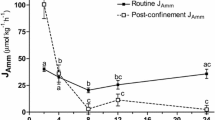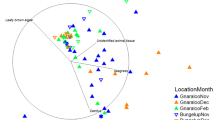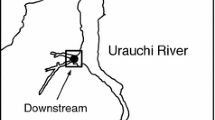Abstract
Field studies were conducted in Johnson Key Basin, Florida Bay, USA from September 2002 through September 2004 to examine physiological, ecological, and behavioral characteristics of the gulf toadfish, Opsanus beta (Goode and Bean in Proc US Natl Mes 3:333–345, 1880), in relation to nitrogen metabolism, habitat usage, and spawning. Fish collected 5 cm above sediments in experimental shelters (epibenthic) were compared with those collected by throw traps which were found on or burrowing within sediments. The relationship between microhabitat ammonia and urea excretion, as determined by the enzymatic activity of glutamine synthetase (GS), was examined. The hypothesis tested was that O. beta occupying epibenthic nests were less ureotelic with lower GS activities than non-nesting individuals on/in sediments, due to a decreased environmental ammonia burden. Porewater total ammonia (T Amm) concentrations at a sediment depth of 5 cm, i.e., the approximate depth of burrowing toadfish, ranged from 0 to 106.5 μmol N l−1 while the pH ranged from 7.48 to 9.14. There was a weak but significant correlation between environmental ammonia (NH3) concentration and hepatic GS activity for epibenthic toadfish (P < 0.001, r 2 = 0.10), but not for burrowing toadfish. Mean urea-N and T Amm concentrations within shelters occupied by toadfish (n = 281) were 9.8 ± 0.83 μmol N l−1 and 13.0 ± 0.7 μmol N l−1, respectively. As predicted, hepatic GS activity was significantly lower in epibenthic toadfish captured in shelters (4.40 ± 0.24 μmol min−1 g−1; n = 281) as compared to individuals on/in sediments (6.61 ± 0.47 μmol min−1 g−1; n = 128). Glutamine synthetase activity generally peaked in March (spawning season) and was lowest in July. Gender differences in hepatic and branchial GS activity were also found during the spawning season, which is attributable to the fact that males brood and guard offspring in their epibenthic nests while females often rest on or burrow into the sediments. Finally, hepatic and branchial GS appeared to have different patterns of enzymatic activity suggesting functional differences in gene expression.





Similar content being viewed by others
References
Anderson PM (2001) Urea and glutamine synthesis: environmental influences on nitrogen excretion. In: Wright PA, Anderson PM (eds) Fish physiology, vol. 20: nitrogen excretion. Academic, New York, pp 239–277
Anderson PM, Walsh PJ (1995) Subcellular-localization and biochemical-properties of the enzymes of carbamoyl-phosphate and urea synthesis in the batrachoidid fishes Opsanus beta, Opsanus tau and Porichthys notatus. J Exp Biol 198:755–766
Barimo JF, Fine ML (1998) The relationship of swimbladder shape to the directionality pattern of underwater sound in the oyster toadfish. Can J Zool 76:134–143
Barimo JF, Walsh PF (2005) The effects of acute and chronic ammonia exposure during early life stages of the gulf toadfish, Opsanus beta. Aquat Toxicol 75:225–237
Barimo JF, Steele SL, Wright PA, Walsh PJ (2004) Ureotely and ammonia tolerance in early-life stages of the gulf toadfish, Opsanus beta. J Exp Biol 207:2011–2020
Brand LE (2002) The transport of terrestrial nutrients to South Florida coastal waters. In: Porter JW, Porter KG (eds) The Everglades, Florida Bay, and coral reefs of the Florida Keys: an ecosystem sourcebook. CRC, Boca Raton, pp 361–413
Breder CM Jr (1968) Seasonal and diurnal occurrences of fish sound in a small Florida bay. Bull Am Mus Nat Hist 138:351–375
Breder CM Jr (1941) On the reproduction of Opsanus beta Goode & Bean. Zoologica 26:229–232
Cameron JN, Heisler N (1983) Studies of ammonia in the rainbow trout: physio-chemical parameters, acid–base behaviour and respiratory clearance. J Exp Biol 105:107–125
DeMartini EE (1991) Spawning success of the male plainfin midshipman. II. Substratum as a limiting spatial resource. J Exp Mar Biol Ecol 146:235–251
Fourqurean JW, Zieman JC, Powell GVN (1992) Relationships between porewater nutrients and seagrasses in a subtropical carbonate environment. Mar Biol 114:57–65
Frankovich TA, Fourqurean JW (1997) Seagrass epiphyte loads along a nutrient availability gradient, Florida Bay, USA. Mar Ecol Prog Ser 159:37–50
Gill TN (1907) Life histories of toadfishes (Batrachoidids), compared with those of weevers (Trachinids) and stargazers (Uranoscopids). Smithsonian Misc Coll 48:388–427
Goode GB, Bean TH (1880) Catalogue of a collection of fishes obtained in the Gulf of Mexico, by Dr. J. W. Velie, with descriptions of seven new species. Proc US Natl Mus 2:333–345
Gray GA, Winn HE (1961) Reproductive ecology and sound production of the toadfish, Opsanus tau. Ecology 42:274–282
Gudger EW (1908) Habits and life history of the toadfish (Opsanus tau). Bull Bur Fish 28:1071–1109
Haywood GP (1983) Ammonia toxicity in teleost fishes: a review. Can Tech Rep Fish Aquat Sci 1177
Hopkins TE, Wood CM, Walsh PJ (1995) Interactions of cortisol and nitrogen metabolism in the ureotelic gulf toadfish Opsanus beta. J Exp Biol 198:2229–2235
Hopkins TE, Serafy JE, Walsh PJ (1997) Field studies on the ureogenic gulf toadfish, in a subtropical bay. II. Nitrogen excretion physiology. J Fish Biol 50:1271–1284
Huggins AK, Skutsch G, Baldwin E (1969) Ornithine–urea cycle enzymes in teleostean fish. Comp Biochem Physiol 28:587–602
Ip YK, Randall DJ, Kok TK, Barzaghi C, Wright PA, Ballantyne JS, Wilson JM, Chew SF (2004) The giant mudskipper Periophthalmodon schlosseri facilitates active NH +4 excretion by increasing acid excretion and decreasing NH3 permeability in the skin. J Exp Biol 207:787–801
Ivancic I, Deggobis D (1984) An optimal manual procedure for ammonia analysis in natural waters by indophenol blue method. Water Res 18:1143–1147
Meeder J, Boyer JN (2001) Total ammonia concentrations in soil, sediments, surface water, and groundwater along the western shoreline of Biscayne Bay with the focus on Black Point and a reference mangrove site. Final Report, National Park Service BISC-N-011.000
Mommsen TP, Walsh PJ (1989) Evolution of urea synthesis in vertebrates: the piscine connection. Science 243:72–75
Orth RJ, Moore KA (1983) Chesapeake Bay: an unprecedented decline in submerged aquatic vegetation. Science 222:51–53
Price NM, Harrison P J (1987) Comparison of methods for the analysis of urea in seawater. Mar Biol 94:307–313
Randall DJ, Tsui TKN (2002) Ammonia toxicity in fish. Mar Pollut Bull 45:17–23
Randall DJ, Wood CM, Perry SF, Bergman H, Maloiy GMO, Mommsen TP, Wright PA (1989) Urea excretion as a strategy for survival in a fish living in a very alkaline environment. Nature 337:165–166
Read LJ (1971) The presence of high ornithine–urea cycle enzyme activity in the teleost Opsanus tau. Comp Biochem Physiol B. 39:409–413
Robblee MB, Barber TR, Carlson PR Jr, Durako MJ, Fourqurean JW, Muehlstein LK, Porter D, Yarbro LA, Zieman RT, Zieman JC (1991) Mass mortality of the tropical seagrass Thalassia testudinum in Florida Bay (USA). Mar Ecol Prog Ser 71:297–299
Robins CR, Ray GC, Douglas J, Freund R (1986) A field guide to Atlantic coast fishes of North America. Houghton Mifflin Company, Boston
Ryder JA (1886) The development of the toadfish. Am Nat 20:77–80
SAS. 1989. SAS/STAT User’s Guide, Ver. 6, Fourth Edition, Vol 2, Cary, North Carolina
Serafy JE, Lindeman KC, Hopkins TE, Ault JS (1997a) Effects of freshwater canal discharge on fish assemblages in a subtropical bay: field and laboratory observations. Mar Ecol Prog Ser 160:161–172
Serafy JE, Hopkins TE, Walsh PJ (1997b) Field studies on the ureogenic gulf toadfish in a subtropical bay. I. Patterns of abundance, size composition and growth. J Fish Biol 50:1258–1270
Sloman KA, McDonald MD, Barimo JF, Wood CM, Walsh PJ (2005) The role of pulsatile urea excretion in the gulf toadfish, Opsanus beta, as a social signal. Physiol Biochem Zool 78:724–735
Sogard SM, Powell GVN, Holmquist JG (1987) Epibenthic fish communities on Florida Bay banks: relations with physical parameters and seagrass cover. Mar Ecol Prog Ser 40:25–39
Walsh PJ (1997) Evolution and regulation of urea synthesis and ureotely in (Batrachoidid) fishes. Aquat Toxicol 59:299–323
Walsh PJ, Milligan CL (1995) Effects of feeding and confinement on nitrogen metabolism and excretion in the gulf toadfish Opsanus beta. J Exp Biol 198:1559–1566
Walsh PJ, Danult E, Mommsem TP (1990) Variation in urea excretion in the gulf toadfish Opsanus beta. Mar Biol 106:323–328
Walsh PJ, Tucker BC, Hopkins TE (1994) Effects of confinement/crowding on ureogenesis in the gulf toadfish Opsanus beta. J Exp Biol 191:195–206
Walsh PJ, Mayer GD, Medina M, Bernstein ML, Barimo JF, Mommsen TP (2003) A second glutamine synthetase gene with expression in the gills of the gulf toadfish (Opsanus beta). J Exp Biol 206:1523–1533
Walters V, Robbins CR (1961) A new toadfish (Batrachoididae) considered to be a glacial relict in the West Indies. Amer Mus Nov No 2047
Wang YX, Walsh PJ (2000) High ammonia tolerance in fishes of the family Batrachoididae (Toadfish and Midshipmen). Aquat Toxicol 50:205–219
Wilkie MP, Wood CM (1991) Nitrogenous waste excretion, acid–base regulation, and ionoregulation in rainbow trout (Oncorhynchus mykiss) exposed to extremely alkaline water. Physiol Zool 64:1069–1086
Wood CM (2004) Dogmas and controversies in the handling of nitrogenous wastes: is exogenous ammonia a growth stimulant in fish? J Exp Biol 207:2043–2054
Wood CM, Hopkins TE, Hogstrand C, Walsh PJ (1995a) Pulsatile urea excretion in the ureagenic toadfish Opsanus beta: an analysis of rates and routes. J Exp Biol 198:1729–1741
Wood CM, Pärt P, Wright PA (1995b) Ammonia and urea metabolism in relation to gill function and acid–base balance in a marine elsamobranch, the spiny dogfish (Squalus acanthias). J Exp Biol 198:1545–1558
Wood CM, McDonald MD, Sundin L, Laurent P, Walsh PJ (2003) Pulsatile urea excretion in the gulf toadfish: mechanisms and controls. Comp Biochem Physiol B 136:667–684
Wood JF, Odum WE, Zieman JC (1969) Influences of seagrasses on the productivity of coastal lagoons. Mem Simp Intern Lagunas Costeras UMAN-UNESCO 495–502
Zieman JC (1982) The ecology of the seagrasses of south Florida: a community profile. US Fish Wildlife Services, Office Biological Services, Washington, DC FWS/OBS-82/25
Acknowledgments
We would like to thank Dr. Michael Robblee, Mr. Andre Daniels, and their crew at U.S. Geological Survey for providing throw trap collected toadfish and Everglades National Park for permitting this field study. Dr. Jerry Lorenz of the Audubon Tavernier Field Station and Mr. Joel Janco provided boat access. Thanks to Dr. Chris Wood, Dr. Robert Cowen, and an anonymous reviewer for helpful comments on this manuscript. This work was funded by National Science Foundation (IOB-0455904) and National Institute of Environmental Health (ESO5705) grants to PJW. All animal research was conducted in accordance with University of Miami assurance (A-3224-01) and the Institutional Animal Care and Use Committee (03-185).
Author information
Authors and Affiliations
Corresponding author
Additional information
Communicated by J.P. Grassle, New Brunswick
Rights and permissions
About this article
Cite this article
Barimo, J.F., Serafy, J.E., Frezza, P.E. et al. Habitat use, urea production and spawning in the gulf toadfish Opsanus beta . Mar Biol 150, 497–508 (2007). https://doi.org/10.1007/s00227-006-0356-7
Received:
Accepted:
Published:
Issue Date:
DOI: https://doi.org/10.1007/s00227-006-0356-7




